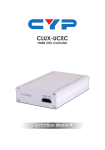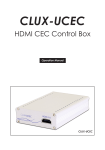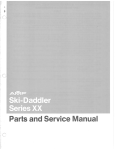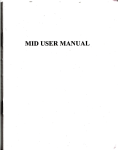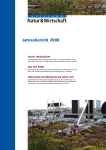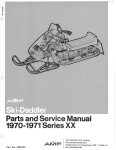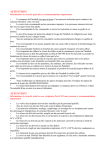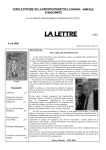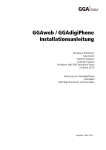Download Word Pro - Operating Instructions.lwp
Transcript
Alpine House Schalom, Oberberg, CH-7076 PARPAN GR
Page 1 of 4
Operating Instructions and House Rules (please have also participants reading this)
Adresses
Telephone
Police
117
Fire department 118
Phycician
Dr. med. Karl Mannhart, FMH f. allg. Medizin,
Hauptstr. 105, Pradafenz, 7075 Churwalden
081 382 0 382
Fax 081 382 0 383
REGA
1414
Rescue helicopter
Hirers
&
Owners
Hanspeter & Vreni Wirth-Scholian
Calunastrasse 8
CH-7000 Chur
Tel. (+41) (0)81 353 86 03
Address of the camp
.................................................
Berghaus Schalom, Oberberg
CH-7076 Parpan GR
Tel. (+41) (0)81 382 18 63
Gemeindeverwaltung Parpan: Tel. (+41) (0)81 382 14 19 (local authorities)
Post Office Parpan
081 382 11 52
Equipment of
the house
- The kitchen has all equipment that is necessary for a camp operation.
- On each matress of the two large bedrooms there are two blankets and one pillow.
- The beds of the small room have the same plus a conventional size (non-nordic) feather cover.
- Two sinks in two separate washrooms and cold tap water, no showers (but an open-air hot tub that
can be heated with fire wood; has space for up to 8 people together), 2 WC's.
- A rescue harness (canvas) and a rescue stretcher are located in the room next to the first WC.
Bring with you
- Kitchen and personal laundry, fire ignition cubes, matches, toilet paper
- Cleaning and dish washing detergent
- Radio with batteries (especially for weather forecast)
- Sleeping bag and cover for pillow (if you like, take bedding-sheets, etc.)
- Flash light, electric torch
Order
in the house
- House shoes compulsary in living-room and bedrooms
- Boots for hiking or skiing to be put onto the metallic roller shelve in the living-room (dry and warm)
- Dogs are not welcome
- For the personal utensils there are cavities in front of the large bedrooms
- 2 blankets per matress; not to be used outdoors or on floor, except for those marked OUTDOOR (located ontop of cleaning cabinet)
Fire
Caution is better than extinguishing! - In winter no fire fighter will come,
in summer most probably too late.
The house is built of dry wood that burns easily!
- No candles in WC, at sinks, in corridors, bedrooms, basement!
- No unattended fire, not in the fire place in the house nor out-doors!
- Absolute NO SMOKING in the entire house; outside do not throw away cigarettes, etc. or stuff them
into the snow (all will re-appear in spring), but rather discard it with the waste.
- Around the house no fire except within the prepared fire place at the play field!
Smoke detectors
In the upper bedrooms, at the top of the stairs and in the basement there are smoke detectors
installed that produce a tremendously strong high pitch noise, when there is smoke.
They send no alarm to the fire fighters!
They only function as an alarm for the inhabitants. Therefore it is strictly forbidden to manipulate at the
smoke detectors or to remove the batteries (except for momentaneous interuption of a false alarm, but
only by a leader).
Emergency exit devices
- At the windows of the two upper bedrooms there are emergency exit ropes installed.
- They are only to be used in case of an emergency!
- They are no toys (safety hazard)!
- However it would be wise, if the leader would instruct their use within the first days. Actual training
under supervision and precautions at your own risk and in socks only (no shoes nor bare foot, due
to possible spoiling of the house wall).
Page 2 of 4
Fire extinction blankets
These are used, if there is a fire on a table or on the stove, etc. They are located in the living-room
between the two doors of the bedrooms, in the kitchen at the door post and on the upper floor in the
entrance area. The directions for use are printed on the cover.
Bucket pump jet is located in the living-room
- Demonstrate its use on the first day to the whole group, if at all possible.
Fire Extinguishers
These are located on top of the stairs at the left, then also at the bottom of the stairs at the right and
also in the kitchen next to the door. Every guest must be informed about their use (see directions for
use on the sticker). Do not remove seal just for practice. Filling is expensive!
Fire Hose on a roll at the wall in the rear basement right under the trap door; read the operating instructions
- This hose provides water at a pressure of 5 atmospheres in practically unlimited quantity.
- In case of a fire someone must climb down, shut the jet at the jet-end, hand it to the person fighting
the fire and open fully the red valve right under the roll.
- Its use is to be demonstrated to the entire group on the first day, if at all possible.
- In winter check daily, if some water exits the jet (frost protection); caution low flow from well in winter.
Warning: Keep trap door to basement free at all times
Open fire-place
(Possibly smaller pieces on a wooden block next to the fire-place)
Never hack wood on the stone of the fire-place! Only to be done in the basement or outside.
1. Get fire wood from the basement (cut it small yourself); keep wood only in box next to fire-place.
2. Open chimney shutter
3. All the way back in the fire-place lay a grate of branch wood (approx. 5 pieces, depending of
desired size of fire) and ontop of this build with more wood a small „block house”. Inside this start
the fire with paper and small wood. This procedure creates a nice fire. In the course of the burning
process move the pieces closer to each other and add more wood as desired.
4. Do not pull the fire to the front of the fire-place! Otherwise the draft is poor and smoke will enter the
room; additionally the heating effect of the air-warming device will be much reduced.
5. If nobody watches the fire, the spark protection screens must be put in place(avoid fire damage).
6. If possible, let the fire burn down completely in the evening! Last small live coal and ashes should
be shoveled into the closed metal bucket for ashes and put outside, extinguished completely by
pouring water over it and dumped into the ash-bin („Aschensilo”) near the compost pile.
7. With no fire burning close the shutter of the chimney (reduce loss of warm air from the room).
8. Our fire-place is equipped with a special air-warming device. When the fire burns nicely and
especially with good live coal, warm or even hot air will exit on top from the screened openings at
left and right (air intakes are at the bottom left and right). This room-heating can be increased by
running the fans installed in the bottom of the fire-place. The control box is located at the right at
the chimney (blowing power or noise can be adjusted). The blinking lamp reminds to shut the
blowers off, when there is no fire burning!
Fuel Stove
- The operating instructions are located in the cabinet next to the stove or in the operating instructions
for the house; this book is called "Betriebsbuch ....", but is in German only.
- Pour fuel carefully from portable container into tank of stove; do not spill, because of the ugly smell!
- The storage tank is located in the basement and has a hand pump for filling the portable container.
- Only ignite the stove by means of the special wax-paper matches (e.g.FIDIBUS) or with starter cubes
(both located in the cabinet next to the stove; do not use paper or cardboard, etc.).
Wood Stove in kitchen (Type Tiba with large cooking surface)
- First put large pieces of wood onto the grid; ontop of this start the fire with small wood and paper.
- When it burns well, add more wood as needed.
- Clean the cooking surface daily; do not let burn-in anything.
- Get fine and coarse wood from the basement (cut yourself) and keep some in storage (pre-drying).
- It is a good idea to keep some hot water in thermal pots (insulation pots) for use until the stove is
being started again (save wood and gas).
Note: If smoke exits into the kitchen, apply first the special electric blower „Kaminkaltluftzapfenausstossgebläse”.
Propane Gas Heater
Use this for heating small quantities, for which starting the stove would be wasting of fire-wood.
After use close propane containers immediately (not only at night) for safety reasons (a high pressure hose
bursting could become a real bad danger).
Measuring the Energy-consumption - regarding fire-wood and liquid fuel please instruct all your folks
Wood, heating liquid fuel and propane gas will be charged to you according to your consumption.
Therefore when taking over the house you must take a reading of each of the two scales under the
propane bottles and enter it into the list located on the door of the cleaning cabinet; the same you do
at the end of your stay. - At the storage tank for liquid fuel you enter a mark on the list called "Ölliste"
for every full portable container you take; the same you do at the fire-wood storage place in the list
called "Holzbezugsliste" for every "Masskiste" (measuring box) you fill (flat) for use. - Remind your
folks to do it diligently, as it is easily forgotten!
At the end of your stay this all is to be summed up and entered in the sheet "House Return Form/Bill".
Page 3 of 4
Fireworks
- Only to be used on the road to the north of the house; do not direct it towards the house!
- Never on the play field (danger for neighbour house and littering the play field).
Fire in the open: Only at the existing fire location at the edge of the play field.
Water
Summer Operation of the House
Not only in winter, but also in spring and fall it can be very cold at this altitude. If a water line freezes,
then the water supply can be interrupted for a long time; possibly a line could also break. When the
temperature outside falls below freezing, it is a necessary precaution to open the frost protection
valves in kitchen, WC's and wash basins and adjust them for a reasonable continous flow; this flow
must be checked daily, since it reduces itself unfortunately due to rubber seals swelling!
Winter Operation of the House
Check daily, if the frost protection valves allow for sufficient continous water flow; equally check the
flow through the fire-hose in the rear part of the basement (below the trap door).
Light
Electric Light (from solar electric system)
The light of the sun is being used as the energy source for charging the batteries in the basement.
Their capacity is quite limited. On days with little sun it may happen that they are not fully recharged.
Therefore: Switch-off every light that is not needed. Use a flash light when walking around.
220Volt AC (from sinewave-inverter and the same batteries) can be supplied in small quantity (amperage), if this is requested, for e.g. cassette player,
note-book, charging mobile phones, etc.; it is supplied at the multiple outlet unit (with control lamp) marked so located in the south corner of the livingroom; switching on and off at the remote control box (below control unit of the solar electric system in the double-room); only operate the inverter if
needed, as it also uses battery power, when nothing is connected to the inverter outlet.
Muscle power generator (in the basement): Daily produce some electricity by means of muscle
power to avoid depletion of the batteries - and of course, when they are empty!
Propane Gas Lamps in Living-room, Corridor and Kitchen
This type of lighting is relatively expensive and requires much caution by its users. The gas lamps
should only be operated by people that are properly instructed or who have studied the operating
instructions in the Instructions Book of the house ("Betriebsbuch". Children may not operate them.
The gas lamps in kitchen and corridor should only be used, when the electric light is inoperable due to
empty batteries. The gas lamps in the living-room may be used, if their comfortable light is desired.
After use close propane containers immediately (not only at night) for safety reasons (a high pressure hose
bursting could become a real bad danger).
Flash Lights, Pocket Lights, electric torches
Every guest should be equipped with a personal flash light, so that it is not necessary to light a solar lamp all the time when
going around somewhere in the house.
Dishes, knives,
forks, spoons
for at least 30 Persons available
Broken or damaged items are to be kept till the return of the house and shown as well as entered in
the form "House Return/Bill"; this is also due for lost items.
Food, etc.
It is possible that there could be some mice. Therefore keep food out of their reach, best in well sealed
containers. At the end of your stay take all your perishable supplies with you. You may leave not
perishable supplies in a locker for the next user, if you wish, instead of taking them with you.
Waste
Only put decomposable waste onto the compost pile, at corner to the entrance of the basement.
Separate your waste: Cans, glass, PET beverage bottles (all rinsed!!), paper, cardboard.
Do not incinerate burnable garbage in stove or fire-place (protect our environment).
Put a liner with a capacity of 60 or 110Liters into the large container at the entrance (or a smaller liner
in a smaller bin) and collect all garbage. The full sacks must be tagged with the payment tag
"Entsorgungs-Tarifmarke" located at the bulletin board. Then place the sacks into the garbage
disposal cabine that is located in the village close to the first parking lot (see sketch "Kroki").
Caution: The tag for paying the garbage disposal is COMPULSORY; it will be very expensive and
uncomfortable, if someone's untagged trash is being identified (untagged sacks are opened and
Waste separation
Environment
searched!).
Cleaning
For this see page 2 of the "House Return Form/Bill".
Normally the house is being inspected at the end by an instructed person; the wood stove in the kitchen is
often not properly cleaned. In case of need for additional cleaning a fee can be charged to the tenant.
Transport
In Summer
On the alpine road to the house the use of motor vehicles is generally restricted. Therefore a special
permit is necessary. For each group or family it is possible to request such a permit (only during the
snow-free period) using a special form (download pdf-file from our homepage). The permit is for a
vehicle of max. 3.5tons of weight in total. The fee is CHF 20.- for one week, for each following week
another CHF 10.-; the filled-in form must be sent to the address indicated, together with an envellope
addressed to you (in an emergency situation the permit may also be obtained at Hotel Alpina normally, if open).
In Winter
The snow-covered alpine road, which for the use by pedestrians is being treated with a snow-mobile, if
the weather is good enough, passes about 200m below the house, but driving a car on it is not possible in winter. All material has to be carried by rucksack or transported to the house by using the
rescue-sledge (located in the basement of the alpine house). The house is not located at a skiing
site.
From the local tourist organisation and latest 10days in advance we could organize for you a snowmobile for transport of materials (no people) at an additional cost for you of CHF 100 to 200.
Page 4 of 4
Dangers
in the
Mountains
Fog
At every season fog can appear inexpectedly and disable any orientation.
Therefore never start a tour without map and compass; additionally we recommend an altimeter.
When fog appears, never leave the path. Single participants should never leave the alpine house
without informing about the way and where they go.
Avalanches
In winter 83/84 an avalanche passed by the house 5 Meters north. It cannot be denied by 100% that
the house could be damaged one day.
Therefore: Listen to the weather forecast (a radio is compulsory!)
If snow falls continue for an extended period, listen to (Avalanche report) Lawinenbulletin Tel. 187.
With strong winds in the slopes above the house large quantities of snow can be disposed of, which
can form an avalanche that can reach the house.
If within 24 hours there is snow fall of 50cm or more, the house owner or the person in charge
must be contacted by telephone.
It is possible that the group must be evacuated. Orders of the person in charge, the local authorities or
the police have to be strictly obeyed.
The owner or person in charge will help in finding an alternative to stay in.
The same is true before beginning of the stay in the alpine house, if the local authorities close the
passage to the house and the stay is inhibited or delayed.
During local avalanche threat it is forbidden to use the normal path to Parpan.
Two avalanche paths threaten it. In this case a path very close to the forest needs to be chosen,
unless there are other orders.
During unpredictable weather conditions each participant must be equipped with skiis or
snow-boots. Just for weekends only the person in charge may allow exceptions.
Such extreme situations appear rather seldom, however, for example in winter 98/99 we had to cancel
almost every camp. Surprisingly during that extremely snow-rich winter not a single avalanche came
down in this area!
Our intention is to inform you openly and clearly, not to cause fears.
Warning: Skiing in the slopes above the alp meadows can be most DANGEROUS!
Miscellaneous
- Unmowed meadows must not be stepped on.
- The meadow right below the house between the two little streams down to the corner with the two
little pine-trees belongs to the house and may be used; in summer some cattle of a farmer is grazing
there. In winter build your igloos here, not on neighbour’s land (with spread manure!!).
- If you use the table-tennis table on the meadow, you MUST SPREAD the two green carpets at each
player's end (grass protection); table and carpets must be moved daily for grass protection.
- When playing with a ball on the play-field, close the window-shutters of all southeast windows or
hang the PROTECTION SCREENS over them; also put a board over the basement window. For
hindering balls rolling down the slopes you may install the guard-net for sheep that is being kept next
to the basement door inside.
- The open-air bathing tub (a heavenly experience!) may be used; carefully follow the operating
procedure!
- For saving heating-energy during nights at freezing temperatures all window-shutters should be closed.
- Never step on the roof of the house! (Tiles may break; safety hazard and unnecessary maintenance work for us), except in winter for one person stepping up to very carefully free the snowcovered windows in the roof (WC's and cloak-room).
- The House is not equipped for wheel-chairs unfortunately (corridors and doors are too narrow).
- Pay in cash the taken post cards (cash-box) or enter the amount in the "House Return Form/Bill.
- We will be pleased, if you leave some memory-note in our guest book and if you recommend our
house to others. Earlier guest books and a copy of the photo book of the house construction are also
stored there for you to enjoy. - We are also open for critic and suggestions.
Thanks for your effort reading these instructions to the end. We now wish you and your group a nice and blessed stay.
The Wirth Family
Berghaus Schalom
Oberberg Parpan
2.2.2006 hw




